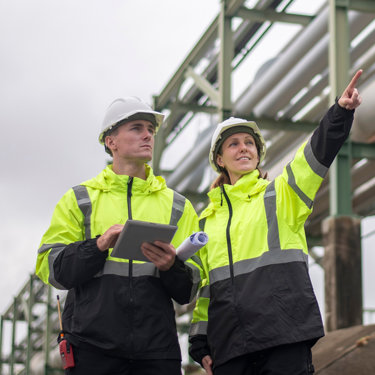
DSEAR risk assessment
Ready to discuss your project?
Please leave your details and a member of our team will reach out to discuss your requirements in more detail and arrange next steps.
We help organisations with workplaces that contain, or have activities that produce, explosive or potentially explosive atmospheres to protect the health and safety of their employees and remain compliant with the Dangerous Substances and Explosive Atmospheres Regulations 2002.
This ensures you understand and mitigate the risks from dangerous substances, protect the environment and reduce operational downtime.
How we help
- Identify if your workplace complies with DSEAR
- Conduct a risk assessment of your workplace
- Prepare a report of prioritised recommendations
- Build a risk matrix and manage remediation work
What is involved in a DSEAR risk assessment?
The DSEAR risk assessment will assess your operation, review any existing DSEAR reports, and make recommendations, such as:
- Requirements for periodic inspection and maintenance of electrical and mechanical apparatus within hazardous areas.
- Creating/updating emergency action plans.
- Providing staff training on working with and handling hazardous products.
- Including the Dangerous Substances and Explosive Atmospheres Regulations 2002 (DSEAR) as part of the health and safety brief for all visitors to areas where a hazardous area is identified.
- Displaying and communicating zone classification drawings.
- Identifying any modification or changes in the substances stored. These must be effectively communicated, and the risk assessment updated, to determine if the hazardous zone classification requires modification.
- Identified hazards are given a priority rating of 1 to 5, allowing your organisation to build a risk matrix and manage remediation work.
Arrange a DSEAR risk assessment
To arrange a DSEAR risk assessment or discuss recommendations, please let us know your details and one of our experts will be in touch.
What is DSEAR?
The primary legislation applying to the control of substances that can cause fires and explosions in the workplace is the Dangerous Substances and Explosive Atmospheres Regulations 2002 (DSEAR).
Many workplaces may contain, or have activities that produce, explosive or potentially explosive atmospheres. Examples include places where work activities create or release flammable gases or vapours, such as vehicle paint spraying, or in workplaces handling fine organic dusts, such as grain flour or wood.
Substances or mixtures that could create risks to people’s safety from fires and explosions or similar events are dangerous substances in accordance with DSEAR 2002. Liquids, gases, vapours, and dusts found in a workplace can all be dangerous substances.
Legal perspective
In Great Britain, DSEAR put into effect requirements from two European Directives: the chemical agents directive (98/24/EC) and the explosive atmospheres directive (99/92/EC).
It also puts into effect the requirements from the ATEX European directives for controlling explosive atmospheres in DSEAR 7 and 11.
The regulations complement the requirements to manage risks, as detailed in the Management of Health and Safety at Work Regulations 1999 document.
The Approved Code of Practice (L138) provides practical advice on how to comply with DSEAR, giving advice on the design, storage, control and safe maintenance of dangerous substances.
Why you must act
DSEAR requires employees to assess the risk of fires and explosions possible because of the use and storage of dangerous substances in the workplace.
These risks must then be carefully managed by elimination or mitigation as far as is reasonably practicable. The aim is to protect employees and other people with potential for exposure to explosive risk, such as visitors to the workplace and members of the public.
DSEAR is enforceable by law, but following the recommendations made in a report is not mandatory.
However, if you fail to remediate the hazards identified in your DSEAR assessment and you have an incident at your organisation, then you could be prosecuted.
Environmental compliance today, creating a sustainable tomorrow
Helping you reduce risk to the environment and your operation by managing assets compliantly while achieving commercial, ESG, and net-zero goals.
Contact our experts

